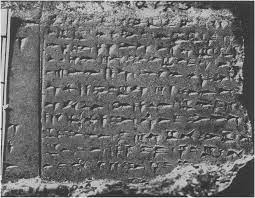Let’s bring our timeline of history into focus: The Bible tells us that Abraham arrived in Canaan 430 years before the Exodus. With the Exodus at 1446 BC, that puts Abraham in Canaan in 1876 BC, just as the fog over the political situation in Mesopotamia lifted with Amorites in control.
So, let’s review:
- Amorite kingdom of Babylon founded — 1894 BC
- Abraham arrives in Canaan — 1876 BC
- Isaac born to Sarah — 1851 BC
- Isaac marries Rebekah — 1811 BC
- Hammurabi crowned king of Babylon at Eridu — 1792 BC
- Jacob and Esau born — 1791 BC
- Abraham dies — 1776 BC
- Hyksos take over Lower Egypt — c. 1750 BC
- Jacob arrives in Egypt — 1661 BC
- Ahmose drives Hyksos out of Egypt — c. 1550 BC
- Moses leads the Exodus — 1446 BC
- Joshua leads the Conquest of Canaan — 1406 BC
Interesting, isn’t it, that the Amorite domination of Mesopotamia began just as God called Abraham and directed him to Canaan? And that Babylon reached the peak of its power with the ascension of Hammurabi the Great just about the time Jacob and Esau were born?
At the same time, a Semitic-speaking, Baal-worshiping state emerged to take control of northern Egypt just before the arrival of the house of Jacob. Wouldn’t it be, you know, coincidental if the Hyksos rulers of Lower Egypt were Amorites, too?
Well, yes, it would—if we believed in coincidences. And as it happens, scholars do believe the Hyksos were Amorites.
The best-known of the Hyksos kings, Khyan, is attested from inscriptions found as far from Egypt as Cyprus and modern-day Baghdad (probably originally in Babylon). An Amorite king with the same name, spelled Hayanu, is listed in a genealogy as a distant ancestor of Šamši-Adad and the royal house of the old Assyrian kingdom.
Scholars have also noticed strong similarities in the burial practices of the Hyksos and various Amorite kingdoms, especially the practice of sacrificing donkeys for burial with important people and under the doorways of new buildings.
So yes, it’s strangely coincidental, if you’re a coincidence theorist. Otherwise, an unseen hand or hands moved the Amorites into position in Egypt and Canaan just before the Israelites arrived—almost as if they’d been placed there to wait for God’s chosen people.
It’s also noteworthy that that the Anakim were confirmed in Canaan by Egyptian texts.
And you know by now we’re not coincidence theorists. Let’s pull these historical threads a little harder. Why did God link the timing of Israel’s return to the iniquity of the Amorites?
We’ve established that the Amorites founded Babylon. This is documented mainstream history. The Amorites are also linked by historic records to a tribe called the Tidnum/Tidanum which seemed to have a strong military reputation, troublesome enough that the last Sumerian kings of Mesopotamia built a very long wall in a futile attempt to keep them away.
The Bible links the Amorites to the Anakim (Deut. 2:10-25). The Israelites’ military campaign in the Transjordan was aimed at the Amorite king Og, who was remembered as a giant. Remember that Og was called the last of the Rephaim (Deuteronomy 3:11). Texts found throughout Mesopotamia identify the Tidnum/Tidanum as a tribe of the Amorites. In Ugarit, the spelling is usually Ditanu or Didanu. And those texts are usually in the context of venerated dead ancestors, especially the honored royal dead.
The city-state of Ugarit, usually described as Canaanite by Bible teachers, was an Amorite kingdom. The tablets found by there archaeologists have provided a wealth of knowledge about ancient Hebrew and history around the time of the Exodus. And some of the connections between secular history, the Bible, and the supernatural realm are absolutely fascinating.
For example, a funerary text identified as KTU 1.161 plainly connects the Amorite tribe of Didanu (Ditanu/Tidnum/Tidanum) with the biblical Rephaim—in a ritual to summon them from the dead!
“Sacrifice of the Shades” liturgy:
You are summoned, O Rephaim of the earth,
You are invoked, O council of the Didanu!
Ulkn, the Raphi’, is summoned,
Trmn, the Raphi’, is summoned,
Sdn-w-rdn is summoned,
Ṯr ‘llmn is summoned,
the Rephaim of old are summoned!
You are summoned, O Rephaim of the earth,
You are invoked, O council of the Didanu!1 (emphasis added)

What?!
Scholars who look at this text from a secular perspective tend to view it as an academic curiosity, a window into the psychology of people who lived 3,500 years ago. But as Christians, filtering this through the lens of truth, we get a whole different picture.
In this ritual, the Rephaim, a group that included the “council of the Didanu,” were invoked to accompany the recently deceased king of Ugarit, Niqmaddu III, to the underworld. They were also there to bless the new king, Ammurapi III, who—although he probably didn’t know it—was the last king of Ugarit. His kingdom was about to be overrun by the so-called Sea Peoples sometime around 1200 BC.
The Rephaim and the council of the Didanu were apparently summoned to impart to the king the power to overcome death, and to make the living king one of the rpum—the Rephaim. Assuming this ritual wasn’t an invention for Ammurapi, and evidence from Babylon suggests it wasn’t, it appears that the coronation rites of the Amorite kings of Ugarit (and maybe other Amorite kingdoms) summoned the king’s dead ancestors, who they identified as the Rephaim.
Imagine a ritual like that in front of the White House on Inauguration Day!
Now, buckle up, because we’re going to work through some challenging stuff in the rest of this chapter. Most of what follows comes from a paper published in 1999 by scholar Amar Annus of the University of Tartu, Estonia,2 whose research into the Mesopotamian origins for some of the weirder themes in the Old Testament, like the Watchers and their sin, is truly groundbreaking.
For starters, Annus concluded that the West Semitic root for the word Rephaim, mrp’, appears to be the origin of the Greek word merops. The word can have a similar meaning in both languages, “healer” or “healing.”
Kos, an island in the southeast Aegean Sea off the coast of Turkey, was formerly called Meropis, after one Merops, the mythical first king of the island. Merops was thought to be an original inhabitant of the land, one who sprang from the rocks and trees as opposed to a foreigner who settled in it. His people, then, were the Meropes.
The key point is that Merops, Meropis, and the Meropes all derive from the Semitic root mrp’–the same root behind the Hebrew word rephaim.
We also find that root as the basis of the phrase meropes anthropoi. That phrase was used by the Greek poet Hesiod in his famous poem Works and Days to describe the men who lived in a long-ago Golden Age.
First of all the deathless gods who dwell on Olympus made a golden race of mortal men who lived in the time of Kronos when he was reigning in heaven. And they lived like gods without sorrow of heart, remote and free from toil and grief: miserable age rested not on them; but with legs and arms never failing they made merry with feasting beyond the reach of all evils. When they died, it was as though they were overcome with sleep, and they had all good things; for the fruitful earth unforced bare them fruit abundantly and without stint. They dwelt in ease and peace upon their lands with many good things, rich in flocks and loved by the blessed gods.
Hesiod, Works and Days
Who were those meropes anthropoi, and what’s the connection to the Rephaim of the Bible? We’ll pick up there next week.
1 Suriano, Matthew J. “Dynasty Building at Ugarit: The Ritual and Political Context of KTU 1.161,” Aula Orientalis 27 (2009), p. 107.
2 Annus, Amar. “Are There Greek Rephaim? On the Etymology of Greek Meropes and Titanes,” Ugarit-Forschungen31 (1999), pp. 13-30.


Thank you! That was fascinating! Can’t wait till next week.